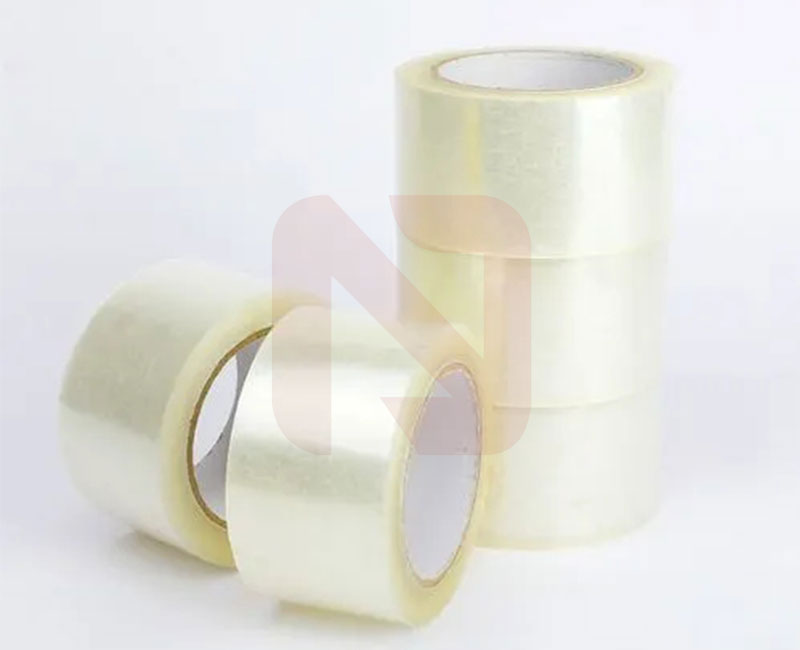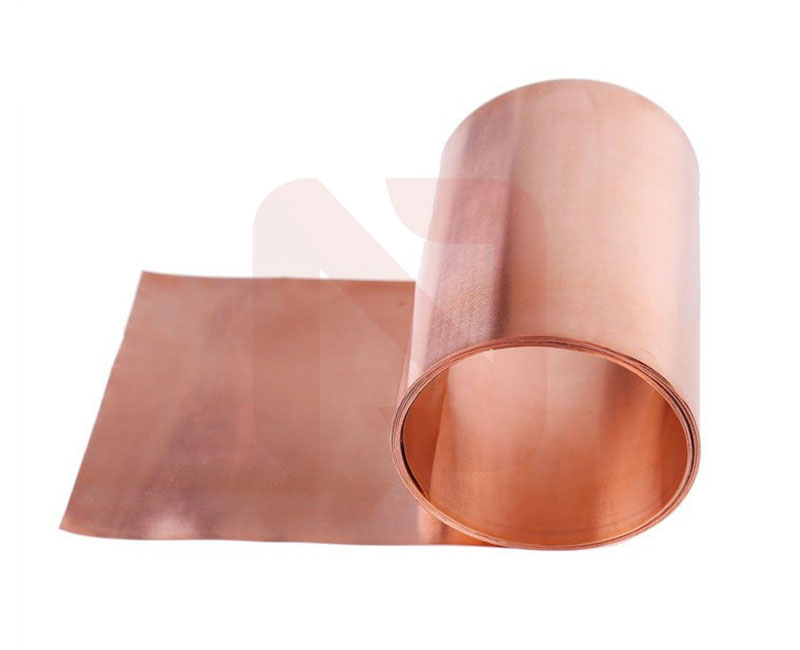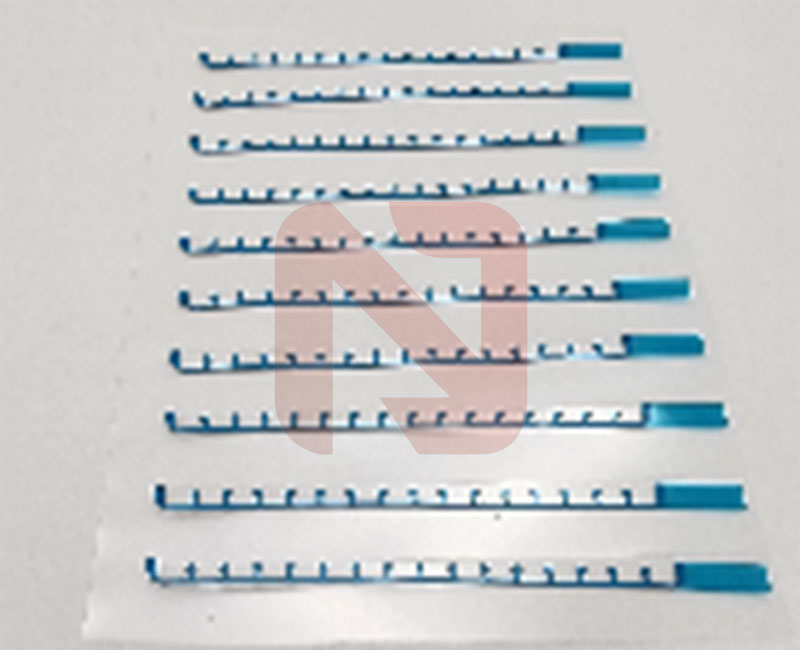In the die-cutting industry, common die-cutting materials can be divided into eight categories, namely: release materials, adhesive series materials, conductive shielding materials, surface protection series materials, sealing/buffering series materials, insulating flame-retardant materials, waterproof and dust-proof series materials, and backlight module series materials.
Release material
The release material is generally used for isolation, filling, protection, tape release, product cover, etc. in die cutting, and has the advantage of easy stripping. During use, release materials with different release force, color and characteristics shall be selected according to different places and requirements.
The commonly used release base materials mainly include: grazin paper, CCK kaolin coated paper, overpressurized paper, coated paper, PE film, PET film, OPP film, PC film, PS isolation film, PMMA release film, BOPP release film, PE release film, plastic film, TPX release film, PVC release film, PTFE release film, PET release film, silicon release film, polyester release film, Teflon release film, composite release film, high-temperature resistant release film, polyphenylene ether release film Polytetrafluoroethylene isolation film, polyethylene release film, composite release film (that is, the base material is composed of two or more materials), etc.
The release is mainly divided into light release, medium release and heavy release.
Adhesive series materials
The earliest adhesive for double-sided adhesive came from animals and plants. In the 19th century, rubber was the main component of adhesive; In modern times, it is widely used in various polymers. Adhesives can stick things because they form bonds between their molecules and the objects they want to connect. This bond can firmly bind molecules together. The components of the adhesive are different polymers according to different brands, types and types.
Adhesives can be divided into: double-sided adhesive tape without substrate, double-sided adhesive tape with substrate and single-sided adhesive tape according to the structure classification.
(1) Double-sided adhesive without base material, such as acrylic adhesive film, is mainly formed by acrylic adhesive, with a thickness of 0.05-0.15mm. The disadvantage is that it cannot be formed and torn off as a whole.
(2) There are base material double-sided adhesive, represented by cotton paper double-sided adhesive, PET double-sided adhesive and foam double-sided adhesive. The double-sided adhesive of cotton paper is made of cotton paper and non-woven fabric as the base material and coated with glue on both sides, with a thickness of 0.10-0.20mm. Non-woven fabric is the most common base material, with the advantages of strong softness and wide application range; The sponge paper substrate has the advantages of good strength and strong softness. PET double-sided adhesive is made of PET as the base material and coated with glue on both sides, with a thickness of 0.01-0.25mm, transparency and thin thickness. Foam double-sided adhesive tape is mainly a double-sided adhesive tape made by applying adhesive on both sides of foam cotton or foaming acrylic, with a thickness of 0.25-3.0mm. It has the advantages of resilience, balanced tension and filling uneven surface.
(3) The single-sided adhesive tape is made of PET, PE, BOPP, PI and other materials as the base material, and is coated with glue on one side, with the glue thickness of 0.03-0.15mm.
Adhesives can be divided into acrylic, synthetic rubber, rubber and silicone according to adhesive classification.
(1) Acrylic, with excellent durability, can be bonded to a variety of substances, short-term temperature resistance can reach 230 degrees, the production process is relatively simple, and the cost is moderate.
(2) Synthetic rubber has good adhesion to various materials, low impedance and low cost. However, it has poor resistance to high and low temperature and aging.
(3) Rubber, with good initial adhesion, can be bonded to various substances, low cost, but temperature resistance, generally not more than 90 degrees, poor chemical resistance, easy aging.
(4) Silica gel has strong resistance to high and low temperature (- 100 ° - 500 °) and aging. It is suitable for bonding products with low surface energy. However, it has high cost, low initial adhesion and is easy to react with strong alkali and hydrofluoric acid.
Adhesives can be classified into pressure sensitive adhesives, hot melt adhesives and conductive adhesives according to application methods.
(1) Pressure sensitive adhesive can be bonded by applying a certain pressure, without solvent or heating, and can provide durable and reliable adhesion (usually reaching the maximum adhesion force in 72 hours).
(2) For hot melt adhesive, the application of hi requires a certain temperature, usually about 120 degrees, to melt the adhesive and produce reversible (thermoplastic cross-linking) or irreversible (thermosetting cross-linking) reactions, thus achieving strong adhesion.
(3) Conductive adhesive, adding conductive metal particles or fibers to the adhesive, or coating adhesive with conductive materials as the base material to form adhesive tapes with different directions of conductivity.
Conductive shielding material
Conductive shielding materials are mainly divided into three categories, including conductive adhesive, conductive foam and conductive cloth.
Conductive adhesive refers to a kind of adhesive with conductive properties. Conductive adhesive is a kind of adhesive with certain conductive properties after curing or drying. It is usually composed of matrix resin and conductive filler, namely conductive particles; The conductive particles are combined by the adhesive action of the matrix resin to form the conductive isomorphism and realize the conductive connection of the bonded material. Because the matrix resin of conductive adhesive is a kind of adhesive, the appropriate curing temperature can be selected for bonding. At the same time, due to the rapid development of miniaturization and miniaturization of electronic components and high-density and highly integrated printed circuit boards, the conductive adhesive can be made into paste to achieve high linear resolution. The process of conductive adhesive is simple, easy to operate, and can improve production efficiency. Therefore, conductive adhesive is an ideal choice to replace lead-tin welding and realize conductive connection. Generally used for circuit board grounding. FPC connection is used.
Conductive foam is made of elastic PU foam wrapped with textile fiber cloth containing metal coating, which has good elasticity and conductivity. It is mainly applicable to the occasions where large pressure cannot be provided, and plays a good role in battery sealing. During processing, it can process different shapes and sizes according to customer requirements, and is widely used for EMI prevention of various electronic products. Conductive foam is divided into ordinary conductive foam and omnidirectional conductive foam. Ordinary conductive foam is mainly conductive by X and Y axes, while omnidirectional conductive foam X, Y and Z can conduct electricity.
Conductive cloth shielding, with highly metallized nylon and polyester materials as the base material, has excellent electrical conductivity equivalent to metal, and has good toughness and winding performance. The back conductive adhesive is an ideal material for shielding various electronic appliances and communication equipment, and is also very suitable for shielding and grounding of circuit boards or various surfaces.
Surface protection series materials
The protective film can be divided into four categories according to its use, including digital product protective film, automobile protective film, household protective film, food preservation protective film, etc.
According to material classification, it can be divided into seven categories, namely PP material, PVC material, PET material, AR material, PE material, OPP material and OCA material.
(1) The protective film made of PP first appeared on the market. Its chemical name is polypropylene, and it has no adsorption capacity. It is generally bonded with glue. After tearing off, the screen surface will leave a mark of glue, which has been basically eliminated.
(2) The protective film made of PVC has a soft texture and is easy to paste, but the material is thick and the light transmittance is poor, making the screen look hazy. In addition, it is easy to turn yellow and produce oil with the change of temperature, and its service life is short.
(3) The protective film made of PET is the most common protective sticker on the market. It is hard, scratch resistant, and will not turn yellow and oil after long use. However, depending on electrostatic adsorption, it is easy to blister and fall off. The price is more expensive than that of PVC, but the PET material protective sticker is exquisite in workmanship and packaging.
(4) The protective film made of OPP is relatively close to the PET protective film in appearance. Its hardness is relatively high, and it has a certain flame retardancy. However, the adhesive effect is poor, and it is rarely used in the general market.
(5) The main raw material of PE protective film is LLDPE, which is soft and has certain tensile property. The general thickness is 0.05mm-0.15mm, and the viscosity varies from 5G-500G according to the use requirements.
(6) The protective film made of AR is the best known screen protective sticker on the market. AR is a synthetic material, generally divided into three layers, silica gel is the adsorption layer, PET is the middle layer, and the outer layer is a special treatment layer. The special treatment layer is divided into AG treatment layer and HG treatment layer. AG is anti-glare treatment, and HG is hardness treatment.
(7) The protective film made of OCA is no different from other materials in appearance, but the protective film made of OCA is produced in Japan and now widely used in Apple phones. It is better than other materials in brightness and hardness, and is the most popular material for collecting protective films.
Sealing/buffering series materials
Foam can be divided into polyethylene foam, polyester foam and rubber foam according to material classification:
·PE foam mainly includes PE foam and EVA foam, of which PE foam is mainly through chemical crosslinking and electronic crosslinking.
·Polyester foam mainly includes polyether foam and polyurethane foam, both of which are formed by chemical foaming and physical foaming.
·Rubber foam mainly includes CR foam (neoprene), NR foam (nitrile rubber), SBR foam (styrene butadiene rubber), EPDM foam (EPDM)
According to the foam structure, it can be divided into open-cell foam and closed-cell foam:
·The open-cell foam is soft, with high water absorption and compression rate, and is suitable for sound absorption sealing applications, such as the compression sponge of earphones and air conditioning sealing strips.
·The closed-cell foam is an independent foam, with low compression residual rate, low water absorption, good heat insulation and cushioning performance, and good dust prevention. It is suitable for sealing and dust prevention of electronic products, waterproof and shock absorption, etc.
Features of sealing/buffering series materials:
(1) Very good shielding effect at low pressure, with shielding efficiency exceeding 90dB;
(2) Elastic, light weight;
(3) Anti-corrosion nickel coating can prevent electrochemical corrosion;
(4) Low surface contact resistance;
(5) Fast pressure sensitive fixation;
(6) The customer can specify the length;
(7) Multiple cross section selection;
(8) UL fire protection;
(9) The product quality is stable;
(10) It is resistant to hot pressure, not easy to fall off, and has high tensile strength;
(11) After the product is installed, the temperature is from - 20 ℃ to 80 ℃;
(12) This quality is still maintained after 72 hours of cycle test;
(13) It has a series of features such as convenient use, flexible bending, ultra-thin volume and reliable performance.
Insulating flame-retardant materials
Insulating and flame-retardant materials mainly include: PC, PVC (such as electrical tape), PET, American ITW-FORMEX material (PP), fast bar sheet, etc.
The commonly used brands include Toray, Mitsubishi, Jianzhong, GE, SKC, ITW, DuPont, etc.
Insulating flame retardant materials have the following four characteristics:
(1) Excellent electrical insulation performance;
(2) Comply with UL standards (most can reach 94V-0 fire rating);
(3) High voltage resistance - can work in high temperature environment above 100 ℃ for a long time;
(4) Some non-halogen flame retardants will not cause environmental pollution (halogen-containing flame retardants still exist in the market at present).
There are the following fire retardant standards in UL94 test:
(1) Level B horizontal combustion test;
(2) 945-V vertical combustion test;
(3) Flame spread index experiment with radiant plate;
(4) 94VTM-0, 94VTM-1, 94VTM-2 vertical combustion test.
Flame retardant grade:
[align=left] The horizontal sample with HB thickness < 3mm burns slowly, and the vertical sample with burning speed < 76mm/minV-0 stops burning in 10 seconds; No droplet V-1 vertical sample is allowed to stop burning within 30 seconds; No droplet V-2 vertical sample is allowed to stop burning within 30 seconds; It is allowed to drop 5 V of combustible material to burn the test bar for 5 times, each time the flame is greater than the flame in the V test, each time lasting for 5 seconds. The combustion stops for 5VB within 60 seconds.
The test sample is burnt through (producing a hole). The 5VA test sample is not burnt through (producing no hole) - UL highest level
Waterproof and dust-proof series materials
There are five main types of gauze: cotton gauze, real silk gauze, single-yarn polyester gauze, nylon gauze and stainless steel gauze.
According to the structure, the mesh can be divided into non-woven fabric, filter screen and punched screen.
(1) Non-woven fabric is a kind of nonwoven fabric. The textile staple fibers or filaments are oriented or randomly strung to form a fabric structure, and then reinforced by mechanical, thermal adhesive or chemical methods. The waterproof effect is achieved by increasing the tension through waterproof treatment.
(2) The filter screen is an industrial fabric woven with synthetic fiber and other raw materials, with uniform and stable air holes on the surface, and has the function of screening and filtering.
(3) Punching net is made by cold punching different materials according to the designed porosity, hole diameter, hole spacing and opening rate of the stamping die, with unique visual effect.
According to the classification of materials, non-woven fabrics include polypropylene (PP), polyester (PET), cotton (PA) and acrylic (PVN), which have the advantages of breathability, dust prevention, heat preservation, waterproof and low price. However, due to non-directionality, the strength is worse than that of textile fabrics, and the acoustic test is unstable; The filter screen has polyester (PET), cotton fiber (PA) and stainless steel (SS). The polyester has high tensile strength and good heat resistance; Cotton fiber is suitable for printing and has good alkali resistance; Stainless steel has the best strength, but it is expensive; The punching screen has polyester PET, which can punch 0.3mm holes at least; Polycarbonate PC is not suitable for micropores less than 0.5mm, stainless steel, etc.
Backlight module series materials
As one of the key components of the LCD panel, the backlight module provides sufficient brightness and is distributed in a uniform light source to enable the display to display images normally.
The key components of the backlight module are mainly composed of light source, light guide plate, rubber frame, reflector, Diffuser, light intensifier (BEF, prism), black and white tape, etc.





